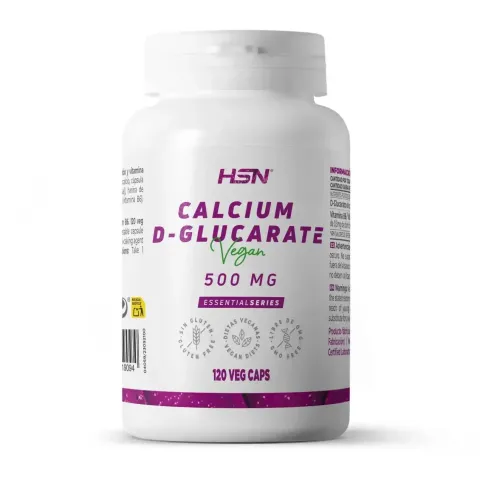- Calcium Salts + Glucaric Acid = Calcium D-Glucarate.
- Important compound with a field of growing study and research.
- Formula with vitamin B6 in the form of highly bioavailable Pyridoxine HCl.
- Compound ideal for middle-aged women and bodybuilding and fitness athletes.
- Compound naturally present in the body. It is synthesized via glucuronic acid.
- High concentration: 500 mg of pure Calcium D-Glucarate per vegetable capsule.
- Suitable for vegetarian and vegan diets.
Calcium D-Glucarate 500 mg - Source of D-Glucaric Acid
Calcium D-Glucarate 500 mg from EssentialSeries is a dietary supplement by HSN developed from the calcium salt of D-glucaric acid, the most representative and scientifically researched form of the compound. The formula has been developed with a high bioavailability form of Vitamin B6 to support the compound’s action.
Calcium D-glucarate is the calcium salt of D-glucaric acid, a substance naturally produced in small amounts by mammals, including humans. Glucaric acid is also found in many fruits and vegetables, with the highest concentrations in oranges, apples, grapefruits, and cruciferous vegetables.
HSN’s Calcium D-Glucarate is a widely used dietary supplement among adult women and bodybuilders due to its nutritional characteristics, and it is also a vegan compound compatible with all types of diets since it provides no calories or allergens.
Calcium D-Glucarate and Vitamin B6 Formula
Calcium D-Glucarate as the main source of D-Glucaric Acid
D-glucaric acid is the compound with the nutritional relevance of the Calcium D-Glucarate form.
D-glucaric acid is not provided in free form because its stability and bioavailability require association with ions such as calcium, in this case, or potassium, for example.
Calcium D-glucarate hydrolyzes into free calcium and D-glucaric acid after entering an acidic environment (stomach acid), and then D-glucaric acid is metabolized into one of two metabolites: D-glucaro-1,4-lactone (30% of ingested D-glucaric acid) or D-glucaro-6,3-lactone (also 30%), while 40% remains as D-glucaric acid.
Therefore, the nutritional interest in calcium D-glucarate lies in the stability of the form itself, and in the nutritional properties of the D-glucaric acid it contains, as well as the metabolites generated from it.
Compound naturally present in the body. Quality control and high purity
D-glucaric acid is not foreign to us; humans produce D-glucaric acid internally through a metabolic pathway via D-glucuronic acid. Also, D-glucarate or D-glucaric acid is widely present in commonly consumed fruits and vegetables.
At HSN, we develop a calcium D-glucarate of high nutritional quality and excellent quality controls to guarantee what we consider essential:
Quality + Effectiveness + Safety of the compounds
Perfect for you and your daily nutrition.
Composition without additives for aesthetic reasons
Calcium D-Glucarate can be developed in many ways, not only as the compound itself but as a product.
For our part, we are clear and want to offer you more with less:
We develop a pure calcium D-glucarate simply and without additives in the compound purification process, while the product is developed in vegetable capsules, without colorants or other aesthetic additives. Our products have the natural appearance they should have, so you enjoy more:
A pure quality formula of D-glucaric acid in calcium salt, with vitamin B6, without all the stuff you don’t need.
High concentration per vegetable capsule - Doses backed by research
At HSN, we review the scientific research supporting the use of each compound we work with.
We have developed a high-concentration Calcium D-Glucarate with half a gram of compound in each vegetable capsule, with a recommended daily dose of 3 capsules providing 1500 mg of pure Calcium D-Glucarate daily.
Composition with vitamin B6 for hormonal support
We have developed our Calcium D-Glucarate formula with a significant amount of Vitamin B6, also known as pyridoxine, in a form (hydrochloride, HCl) with high absorption and bioavailability overall.
Vitamin B6 plays important roles in the body, although we add it to Calcium D-Glucarate for a key role since it helps regulate hormonal activity.
Natural sources of Calcium D-Glucarate compared to a supplement
Although natural sources of D-glucaric acid exist, especially in fruits and vegetables, their concentration is very low. Notable sources include oranges, carrots, spinach, apples, broccoli, alfalfa sprouts, and potatoes.
However, even though oranges are by far the dietary source with the highest glucaric acid content, they only provide 4–5 mg per 100 g of fruit.
Our Calcium D-Glucarate provides 1500 mg of pure Calcium D-Glucarate per daily dose, making it the ideal support for people looking to use this important and increasingly studied nutrient.
Combine it with other synergistic activity products! We help you choose
Calcium D-glucarate can be combined with multiple compounds, as it has no known contraindications for joint use with any common dietary supplement nutrients.
Anyway, when we talk about synergistic combination, we mean combined use with other compounds that make nutritional sense to use together, and in this case, there is one that pairs with Calcium D-Glucarate above others: Resveratrol.
Combine resveratrol with Calcium D-glucarate for an unbeatable combo.
Bibliographic references:
- Zółtaszek, R., Hanausek, M., Kiliańska, Z. M., & Walaszek, Z. (2008). Biological role of D-glucaric acid and its derivatives; potential medical applications. Postepy Higieny i Medycyny Doswiadczalnej, 62, 451–462.
- Walaszek, Z., Szemraj, J., Narog, M., Adams, A. K., Kilgore, J., Sherman, U., & Hanausek, M. (1997). Metabolism, uptake, and excretion of a D-glucaric acid salt and its potential use in cancer prevention. Cancer Detection and Prevention, 21(2), 178–190.
- Dwivedi, C., Heck, W. J., Downie, A. A., Larroya, S., & Webb, T. E. (1990). Effect of calcium glucarate on β-glucuronidase activity and glucarate content of certain vegetables and fruits. Biochemical Medicine and Metabolic Biology, 43(2), 83–92.
 Before
Before After
After During
During Morning
Morning Afternoon
Afternoon Night
Night


















